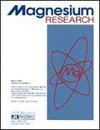镁与老年患者:已探索的路径与有待探索的路径综述。
IF 1
4区 医学
Q4 BIOCHEMISTRY & MOLECULAR BIOLOGY
引用次数: 12
摘要
镁是一种重要的二价阳离子。它在人体机体中的良好平衡是极其重要的,并涉及广泛的功能。我们需要将其在人体组织中的含量维持在生理范围内。这对老年人尤其如此,特别是对“虚弱”的老年人,他们的系统和设备处于严重的稳态不稳定状态。事实上,低镁血症涉及非常广泛的病理状况(需要多种治疗),可能损害老年人的自主性。这次审查的目的是通过最重要的试验,以便了解过去几年研究所采取的方向,并发现这一领域的改进空间。我们试图了解镁含量何时是真正的生理或病理,以及我们如何防止老年人镁摄入量过低。首先,我们已经指出,绝对需要一个适当的评估方法的镁含量在人体组织。目前的文献适当地鼓励使用镁血清浓度、尿排泄和饮食摄入的综合评估。我们还讨论了有关低镁血症与人类病理的最重要的试验。对老年患者进行的具体研究已经广泛证明了其在维持骨骼健康、充分的糖代谢补偿、正确的心脏和血管功能概况以及生理心理认知概况方面的决定性作用。因此,从上面讨论的含义来看,确保体内镁的生理水平是至关重要的,特别是在老年患者中,它本身更容易减少阳离子水平。根据文献,我们得出结论,预防老年低镁血症及其临床意义的最佳方法是适当的饮食(多纤维和复合碳水化合物,多植物蛋白,少糖和脂肪),以确保充足的阳离子供应。如果仅通过饮食(由于合并症或其他伴随因素)无法保证适当的血清阳离子水平,或者在患者被定义为“虚弱的老年人”的情况下,在仔细分析肾功能后,将进行重新融入治疗(per os)。本文章由计算机程序翻译,如有差异,请以英文原文为准。
Magnesium and elderly patient: the explored paths and the ones to be explored: a review.
Magnesium is an essential bivalent cation. Its fine balance in human organism is extremely important and is involved in a wide range of functions. We need to maintain its amount in human organism within range considered as physiological. This is particularly true for elderly people, and especially for "frail" elderly people, whose systems and apparatuses are in a state of serious homeostatic precariousness. In fact, hypomagnesemia is involved in a very large range of pathological conditions (requiring multiple therapies) that could compromise elderly's autonomy. The aim of this review has been to go through the most important trials, in order to understand the direction taken by research during the last years and to detect the room for improvement in this field. We have tried to understand when magnesium content is truly physiological or pathological, and how we could prevent an inappropriately low magnesium intake in elderly people. First of all, we have remarked the absolute need of an adequate evaluation method for magnesium content in human organism. Current literature appropriately encourages the use of a synoptic assessment of magnesium serum concentration, urinary excretion, and dietary intake. We have also discussed the most important trials relating hypomagnesaemia with human pathology. Specific studies conducted on elderly patients have extensively demonstrated its decisive role in maintaining bone health, adequate glyco-metabolic compensation, a correct cardiac and vascular functional profile, and probably also a physiological psycho-cognitive profile. From the implications discussed above, therefore, it is essential to ensure physiological levels of magnesium in body, particularly in geriatric patient, itself more prone to a reduction in the level of cation. We have concluded, according to the literature, that the best way to prevent hypomagnesemia and its clinical implications in elderly subjects is represented by a proper diet (more fiber and complex carbohydrates, more vegetable proteins, less sugars and fats), which ensures an adequate supply of cation. If with diet alone (due to comorbidity or other concomitant factors) it has not been possible to guarantee suitable serum levels of cation, or in the case of a patient defined as "frail elderly", a reintegration therapy (per os) will be undertaken, after a careful analysis of renal function.
求助全文
通过发布文献求助,成功后即可免费获取论文全文。
去求助
来源期刊

Magnesium research
医学-内分泌学与代谢
CiteScore
3.50
自引率
9.40%
发文量
6
审稿时长
>12 weeks
期刊介绍:
Magnesium Research, the official journal of the international Society for the Development of Research on Magnesium (SDRM), has been the benchmark journal on the use of magnesium in biomedicine for more than 30 years.
This quarterly publication provides regular updates on multinational and multidisciplinary research into magnesium, bringing together original experimental and clinical articles, correspondence, Letters to the Editor, comments on latest news, general features, summaries of relevant articles from other journals, and reports and statements from national and international conferences and symposiums.
Indexed in the leading medical databases, Magnesium Research is an essential journal for specialists and general practitioners, for basic and clinical researchers, for practising doctors and academics.
 求助内容:
求助内容: 应助结果提醒方式:
应助结果提醒方式:


